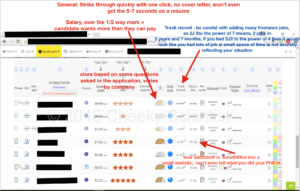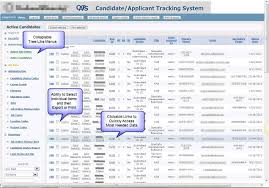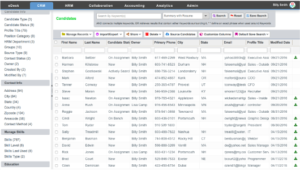You may have heard that the first step to getting a job interview is making it past the stage where a recruiter looks at your CV or Resume and makes a split-second decision about whether to chuck your Resume into the discard pile. So, is your Resume destined to the garbage can? Or will an actual human being get to read it? Many companies have what is called an Applicant Tracking System (ATS). There are many brands, including Taleo and Bullhorn. How do you know if a company uses an ATS? How do you get around them?
 First, let’s review why employers use these tracking systems. Well, they help employers save time and paper and keep them stay organized. Without them, recruiters would have to spend much more time filing and shredding papers or moving and deleting emails. With applicant tracking systems, there is no risk of an employer accidentally deleting the email containing the Resume of the applicant the company wants to hire. An ATS also makes it easy for employers to keep tabs on the hiring process and to communicate with applicants directly. Just as companies use software applications to keep track of relevant information on their customers, using similar software to organize information on prospective employees makes sense for employers.
Employers also use these tracking systems to review your social media pages. The prevailing sentiment is that having a social media presence helps more than it hurts when it comes to looking for a job, and most job seekers already understand the importance of presenting a professional image on social media. Of course, when it comes to attracting ATS, it is more than just a matter of not posting pictures of your drunken exploits on Facebook. There is social recruiting software that searches the web for specific keywords, and the best way to get noticed is to have a social media profile that includes basic details about your education, work experience, and skills.
First, let’s review why employers use these tracking systems. Well, they help employers save time and paper and keep them stay organized. Without them, recruiters would have to spend much more time filing and shredding papers or moving and deleting emails. With applicant tracking systems, there is no risk of an employer accidentally deleting the email containing the Resume of the applicant the company wants to hire. An ATS also makes it easy for employers to keep tabs on the hiring process and to communicate with applicants directly. Just as companies use software applications to keep track of relevant information on their customers, using similar software to organize information on prospective employees makes sense for employers.
Employers also use these tracking systems to review your social media pages. The prevailing sentiment is that having a social media presence helps more than it hurts when it comes to looking for a job, and most job seekers already understand the importance of presenting a professional image on social media. Of course, when it comes to attracting ATS, it is more than just a matter of not posting pictures of your drunken exploits on Facebook. There is social recruiting software that searches the web for specific keywords, and the best way to get noticed is to have a social media profile that includes basic details about your education, work experience, and skills.
 Now, what should you do to get noticed and pass the ATS system? The biggest key is to tailor your Resume specifically for each job application you submit. Whether this means making major or minor changes, your Resume should make clear why you are an excellent candidate for that specific job. Every employer is looking for certain qualifications, whether Resumes will first be scanned by a recruiter or by keyword-seeking ATS. You should find out as much as possible about the organization to which you are applying. If current employees of the company have social media profiles, especially on LinkedIn, see if you have similar qualifications or keywords. In addition, recruiters are looking for concrete information.
Now, what should you do to get noticed and pass the ATS system? The biggest key is to tailor your Resume specifically for each job application you submit. Whether this means making major or minor changes, your Resume should make clear why you are an excellent candidate for that specific job. Every employer is looking for certain qualifications, whether Resumes will first be scanned by a recruiter or by keyword-seeking ATS. You should find out as much as possible about the organization to which you are applying. If current employees of the company have social media profiles, especially on LinkedIn, see if you have similar qualifications or keywords. In addition, recruiters are looking for concrete information.
 Finally, how do you know if a company is using an ATS system? Well, that’s darn easy once you know. Typically, it’s in the URL or the page their system brings you to, has the Taleo or Bullhorn logo on it.
So when applying for a job online, remember that error-prone applicant tracking systems kill 75 percent of job seekers’ chances of landing an interview as soon as they submit their Resumes, despite how qualified they may be. Job seekers’ only hope for rising through these systems is to understand exactly how these systems work and how best to optimize their Resumes for them. You should be one of them!
Finally, how do you know if a company is using an ATS system? Well, that’s darn easy once you know. Typically, it’s in the URL or the page their system brings you to, has the Taleo or Bullhorn logo on it.
So when applying for a job online, remember that error-prone applicant tracking systems kill 75 percent of job seekers’ chances of landing an interview as soon as they submit their Resumes, despite how qualified they may be. Job seekers’ only hope for rising through these systems is to understand exactly how these systems work and how best to optimize their Resumes for them. You should be one of them!
 First, let’s review why employers use these tracking systems. Well, they help employers save time and paper and keep them stay organized. Without them, recruiters would have to spend much more time filing and shredding papers or moving and deleting emails. With applicant tracking systems, there is no risk of an employer accidentally deleting the email containing the Resume of the applicant the company wants to hire. An ATS also makes it easy for employers to keep tabs on the hiring process and to communicate with applicants directly. Just as companies use software applications to keep track of relevant information on their customers, using similar software to organize information on prospective employees makes sense for employers.
Employers also use these tracking systems to review your social media pages. The prevailing sentiment is that having a social media presence helps more than it hurts when it comes to looking for a job, and most job seekers already understand the importance of presenting a professional image on social media. Of course, when it comes to attracting ATS, it is more than just a matter of not posting pictures of your drunken exploits on Facebook. There is social recruiting software that searches the web for specific keywords, and the best way to get noticed is to have a social media profile that includes basic details about your education, work experience, and skills.
First, let’s review why employers use these tracking systems. Well, they help employers save time and paper and keep them stay organized. Without them, recruiters would have to spend much more time filing and shredding papers or moving and deleting emails. With applicant tracking systems, there is no risk of an employer accidentally deleting the email containing the Resume of the applicant the company wants to hire. An ATS also makes it easy for employers to keep tabs on the hiring process and to communicate with applicants directly. Just as companies use software applications to keep track of relevant information on their customers, using similar software to organize information on prospective employees makes sense for employers.
Employers also use these tracking systems to review your social media pages. The prevailing sentiment is that having a social media presence helps more than it hurts when it comes to looking for a job, and most job seekers already understand the importance of presenting a professional image on social media. Of course, when it comes to attracting ATS, it is more than just a matter of not posting pictures of your drunken exploits on Facebook. There is social recruiting software that searches the web for specific keywords, and the best way to get noticed is to have a social media profile that includes basic details about your education, work experience, and skills.
 Now, what should you do to get noticed and pass the ATS system? The biggest key is to tailor your Resume specifically for each job application you submit. Whether this means making major or minor changes, your Resume should make clear why you are an excellent candidate for that specific job. Every employer is looking for certain qualifications, whether Resumes will first be scanned by a recruiter or by keyword-seeking ATS. You should find out as much as possible about the organization to which you are applying. If current employees of the company have social media profiles, especially on LinkedIn, see if you have similar qualifications or keywords. In addition, recruiters are looking for concrete information.
Now, what should you do to get noticed and pass the ATS system? The biggest key is to tailor your Resume specifically for each job application you submit. Whether this means making major or minor changes, your Resume should make clear why you are an excellent candidate for that specific job. Every employer is looking for certain qualifications, whether Resumes will first be scanned by a recruiter or by keyword-seeking ATS. You should find out as much as possible about the organization to which you are applying. If current employees of the company have social media profiles, especially on LinkedIn, see if you have similar qualifications or keywords. In addition, recruiters are looking for concrete information.
No one cares anymore if you’re a “team-player” or “out-going” or “dedicated”. Those are characteristics that are expected. You need to focus on keywords – for example, if you’re applying for a restaurant manager position, look-up what a restaurant manager or someone in hospitality is responsible for, and include that in your Resume.
 Finally, how do you know if a company is using an ATS system? Well, that’s darn easy once you know. Typically, it’s in the URL or the page their system brings you to, has the Taleo or Bullhorn logo on it.
So when applying for a job online, remember that error-prone applicant tracking systems kill 75 percent of job seekers’ chances of landing an interview as soon as they submit their Resumes, despite how qualified they may be. Job seekers’ only hope for rising through these systems is to understand exactly how these systems work and how best to optimize their Resumes for them. You should be one of them!
Finally, how do you know if a company is using an ATS system? Well, that’s darn easy once you know. Typically, it’s in the URL or the page their system brings you to, has the Taleo or Bullhorn logo on it.
So when applying for a job online, remember that error-prone applicant tracking systems kill 75 percent of job seekers’ chances of landing an interview as soon as they submit their Resumes, despite how qualified they may be. Job seekers’ only hope for rising through these systems is to understand exactly how these systems work and how best to optimize their Resumes for them. You should be one of them! 